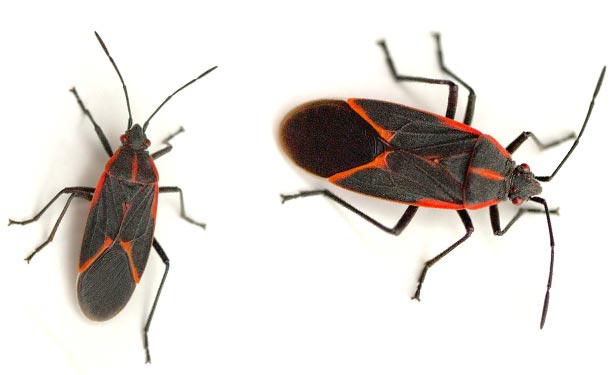Boxelder bugs are nuisance pests, which can be found congregating in large numbers wherever boxelder trees are located. They are fast to reproduce and can reach infestation proportions quickly.

Control measures for boxelders should take place in the summertime before they find their way into your home during the fall months.
The team at thetreecareguide.com has researched ways for you to not only control these pests outside, but to prepare your home and stop them from getting in.
Boxelder Bug Appearance and Habitat
The adult boxelder bug (Boisea trivittata) is about ½ inch long and dark brown or black in color with an elongated oval shape. These insects can be identified by their bright red markings along the edges of their wings and on their abdomen. Nymphs are shorter and bright red in color before developing their wings. Their name is derived from the boxelder tree which they feed on and lay their eggs on.
Boxelder bugs can be found nearly everywhere across the US and parts of Canada in spring, summer and fall. During the warmer months, they will congregate (sometimes in large numbers) on South and West facing walls, stones, and decks to bask in the sun. They become a nuisance in the fall when they seek refuge in structures (often homes) to overwinter.
What Do Boxelder Bugs Eat?
Boxelder bugs will live out their lifecycle near female boxelder trees. It is the seeds and new foliage of the female which compose nearly the entire diet of the insect. In the absence of the boxelder, they will feed on the seeds and newly developing leaves from ash and maple trees.

Foliage on trees occupied by boxelders will be discolored, and in severe infestations will end up deformed. Occasionally, they will also invade plum and apple trees feeding on the fruit, and in doing so, will leave dark spots on the fruit from puncturing its skin.
How to Get Rid of Boxelder Bugs Outside
The absolute solution to a boxelder bug recurring nuisance is to remove the trees they feed on. Otherwise, continuous treatment will be necessary to curb their population.
When planning your landscape design, avoid planting trees that attract the insect.
Conventional pesticides generally have little effect on these insects. However, a simple solution of laundry detergent and water is extremely effective when sprayed directly on them.
Watch this video to see how the water and detergent mixture is used.
A two-step approach should be used when the bugs start to collect on walls, stones, decks, and other surfaces:
Step 1 – Spray the area where they are congregating with a residual insecticide.
Step 2 – Directly spray the bugs with a water and laundry detergent solution.
As boxelder bugs will overwinter relatively close to the trees that they occupy and feed on, it is essential to prepare the outside of your home, shed, or other structure by doing the following.
- Repair or replace torn screens.
- Seal cracks around window frames and doors.
- Make sure doors and windows close flush, creating a seal.
- Add door sweeps to create a barrier at the bottom of all exterior doors.
- Patch any holes, cracks, or fissures on the structure’s exterior.

Boxelder Bug Control Inside Your Home
Controlling boxelder bugs becomes much more difficult once large numbers of them find a way into your home. While the bugs – within the walls, crevices, and attic – are cold, they will remain inactive. However, if they are warmed by the home’s heating system or furnace, they will become active and begin to move around the house.
These bugs don’t feed or reproduce within the home. However, their fecal matter will leave reddish-orange stains on furniture, curtains, and walls. When removing them from your home, take note of the following:
- When boxelder bugs are disturbed or handled, they will emit a strong unpleasant smell. This instinctive reaction is one of the reasons they are able to congregate in open sunny spaces, as the usual insect predators tend to avoid them. This is also why they are sometimes (mistakenly) referred to as “stink bugs.”
- Do not attempt to kill this or other insects deep within crevices or spaces in which you cannot remove them. Decomposing insect bodies can attract dermestid (skin) beetles.
- Household bug sprays and some spray cleaners can be very effective when applied directly to boxelder bugs.
- Using a vacuum cleaner is an advantageous “hands-free” solution. However, this is a temporary fix if the insect’s point(s) of entry have not been sealed or fixed. Make sure to dispose of the vacuum bag or canister contents. Otherwise, the bugs may simply crawl back out.
- Unless corrective measures are taken, boxelder bugs will continue to invade your home and remain a nuisance throughout mid to late spring. By May, the infestation should come to an end, as the insects will have either moved back to their host tree or died.
- Boxelder bugs are not known to go around biting people. However, when they are handled, their mouthparts could pierce the skin resulting in what appears to be a mosquito bite.
Watch this video to learn how to deal with boxelder bugs.
Tree Insects, Your Landscape, and Your Home
Getting rid of boxelder bugs begins with controlling them outside, carefully planning your landscape design, and preparing your home to keep them out.
Avoid planting boxelder, maple, apple, plum, and ash trees. When you see them, spray the area (outside) with a residual pesticide, followed up by spraying them directly with a water and soap solution. Finally, patch up any holes or potential entry points around your home to keep them outside.
Boxelder bugs invading your home in the fall is one of the potential consequences of not taking action against them. Remove their food source, control them outside, and take steps to keep them out of your home.
Sources:
https://en.wikipedia.org/wiki/Boxelder_bug
https://www.pestworld.org/news-hub/pest-articles/boxelder-bugs-101/
https://www.fs.usda.gov/Internet/FSE_DOCUMENTS/fsbdev2_026586.pdf
https://wimastergardener.org/article/boxelder-bug-boisea-trivittatus/